Every few years, California bursts into a riot of colors as millions of wildflowers carpet the hills, valleys, and deserts in a phenomenon known as a superbloom. It happened in 2023, and now, in 2024, the famous California Superbloom is set to unfold once more.
All the experts agree that this year’s California superbloom is bound to be spectacular. Here’s what you need to know.
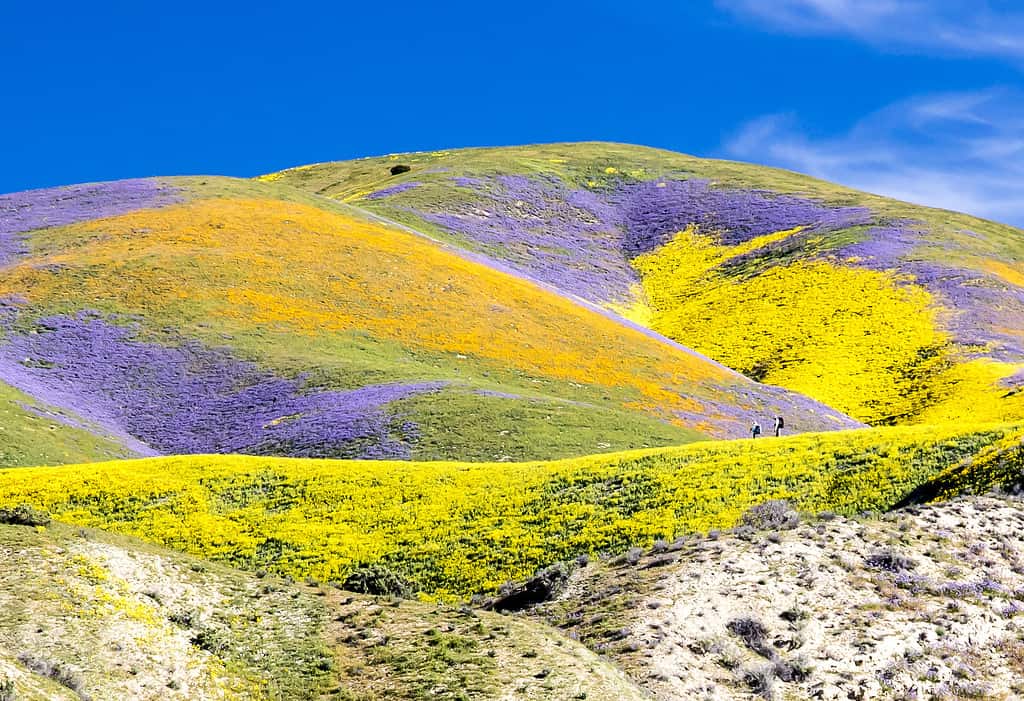
California’s 2024 Superbloom
A superbloom is an exceptionally vibrant display of wildflowers that bloom simultaneously, creating a breathtaking sight that has begun to emerge in parts of Southern California. Evan Meyer, a botanist and the Executive Director of the Theodore Payne Foundation, notes that billions and billions of seeds are already released as the flowers unfold the dazzling display of color.
The superbloom is a relatively rare event in which an exceptional number of wildflowers bloom at once, painting the landscape with an array of colors. You can even see it from space.
This happens in one of the wettest years in recorded history, with several areas in the state still struggling with leftover flooding. In fact, a wet winter is necessary for a superbloom to emerge. Without sustained precipitation, there’s no chance of a superbloom.
Expert Danny McCamish, senior environmental scientist at Anza-Borrego Desert State Park in eastern San Diego County, California, also says we’re set for a remarkable bloom, especially in southern California.
This natural spectacle is not confined to California; wildflowers transform landscapes in Arizona, Nevada, and beyond. However, Southern California is renowned for its particularly dense and spectacular displays. The timing and magnitude of wildflower blooms vary annually, heavily influenced by winter and spring weather conditions, making each year’s bloom unique and unpredictable.
The California 2023 Superbloom
It’s uncommon for two years in a row to have a superbloom, but this is exactly what we’re seeing now.
Last year, the superbloom was also impressive, thanks to the ample winter rains that have saturated the ground, providing the perfect growing conditions for these vibrant flowers.
“This is definitely one of the benefits to a wet year like we just had,” said Gabe Garcia, the head of the Bakersfield field office of the Bureau of Land Management, for NPR. “For perspective, last year this area [looked like] it was mowed. No vegetation coverage. Almost like dirt.”
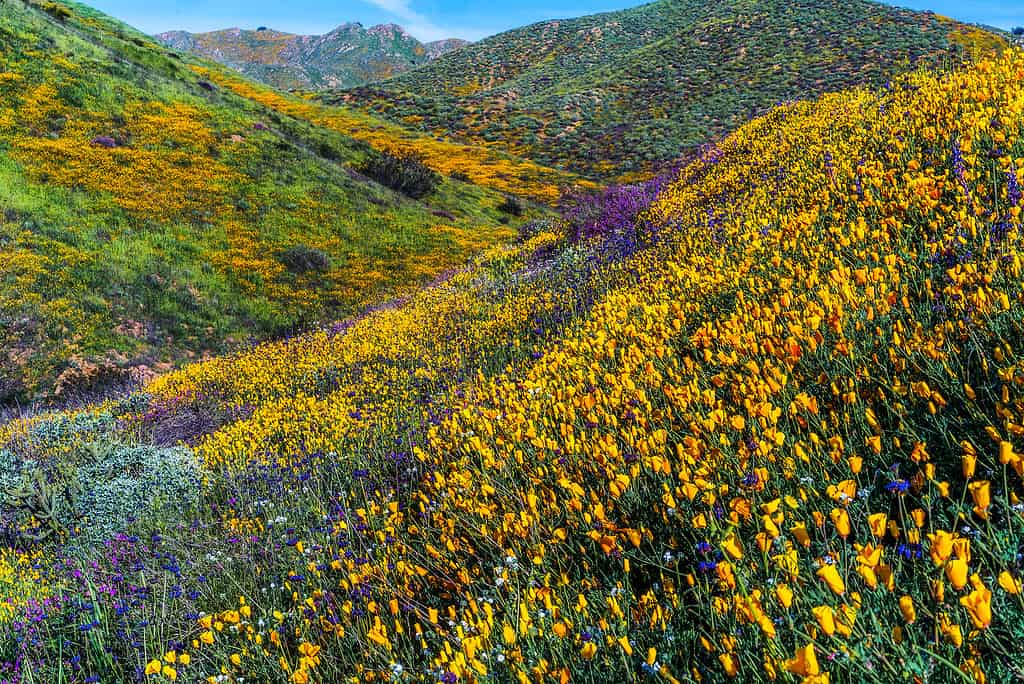
In California, superblooms occur around every ten years. In the past couple of decades, this trend has changed as the state has had extensive periods of drought. Still, we’re blessed with a few superblooms in this decade.
The previous one was in 2019, and before that, there was one in 2017. The 2023 superbloom is not as impressive as the one in 2019, but it’s still pretty amazing.
Throughout multiple areas of California, fields of yellow, orange, purple, and red flowers stretch out as far as the eye can see. It’s a breathtaking sight, and it has the fragrance to go with it. The scent of the flowers wafted through the air, and the hum of bees and other pollinators fills your ears.
It is a truly mesmerizing experience that you won’t want to miss. However, as visitors flock to the “Meccas” of the super bloom, authorities are warning visitors to be responsible. In 2019, Lake Elsinore, an area known for its golden poppies, bloom, was harmed.
Lake Elsinore has banned visitors to Walker Canyon after hundreds of thousands of people came each weekend during the 2019 season, trampling the flowers and affecting wildlife. Now, authorities are trying to redirect some of that tourist flow to other areas that are just as attractive. So far, authorities say, it’s going quite smoothly.
Here’s what you need to know about the superbloom and how to enjoy it responsibly.
What Is a Superbloom?
The superbloom is one of the most amazing natural phenomena you can witness. But what causes these rare and spectacular events?

There’s no scientific definition for what constitutes a superbloom, expert Daniel Winkler, a research ecologist with the U.S. Geological Survey, Southwest Biological Science Center, told The Times.
‘Super bloom’ or ‘superbloom’ came up as a label in the 1990s. It refers to a phenomenon in which wildflower seeds start blooming suddenly over fast stretches, at the same time. The wildflowers’ seeds lay dormant in desert soil and start germinating and blossoming at roughly the same time.
In California, these conditions typically involve ample rainfall during the winter months, followed by warm temperatures and plenty of sunshine in the spring. But there’s another requirement: the desert must remain dry enough prior to the bloom to ensure that the invasive weeds that compete with flowers don’t suck up all the moisture.
Here’s what conditions need to be met in order for a superbloom to happen:
- Sufficient rainfall: A superbloom occurs when there is a higher-than-average amount of rainfall during the winter and spring months in California.
- Not too much rain: If it rains too much, the water can take the seeds away.
- Rain timing: the rain also has to happen at the right time. The desert must receive rainfall in the autumn. This enables the water to penetrate deep into the soil matrix, reaching the dormant seeds of flowering plants. Otherwise, the invasive weeds take over.
- Adequate winter chilling: Many wildflower species require a certain amount of winter chilling (periods of cold weather) in order to germinate and grow properly.
- Correct temperature: The temperature during the growing season should be neither too hot nor too cold for the flowers.
- Lack of frost: Frost can damage or kill wildflowers, so a superbloom is more likely to occur in areas where frost is not a significant concern.
- Limited wildfires: Wildfires can destroy wildflowers and their habitats, so a low incidence of wildfires in the preceding years can increase the chances of a superbloom occurring.
- No major winds or storms: These can wipe the seeds and flowers.
It’s only when all these factors come together that a superbloom can happen. You can probably see why it’s not all that common.
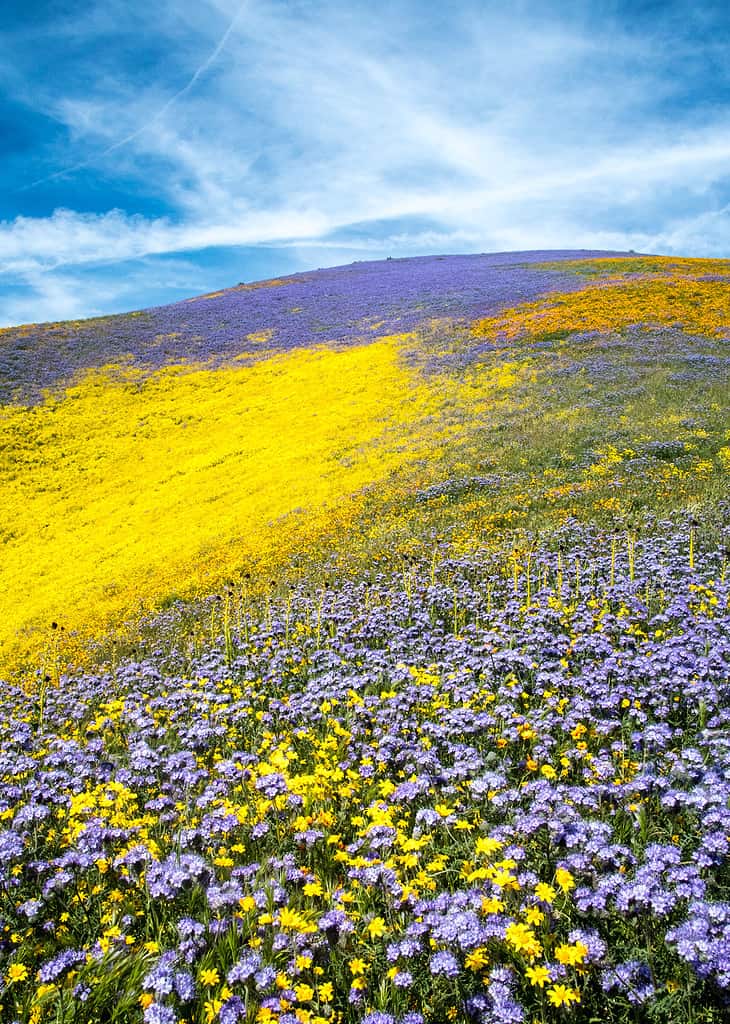
When to See the California Superbloom
As mentioned, the superbloom doesn’t happen every year in California. Even when it does happen, it’s hard to foresee it, and there’s no fixed period in which it happens.
The timing of the superbloom can vary depending on several factors, including the location and the weather conditions. In general, however, the superbloom in California typically occurs in late winter to early spring, so from mid-February to mid-May. In 2023, it’s expected to last for a couple more weeks.
If you’re planning to visit California to see the superbloom, it’s important to keep an eye on the weather forecast and the bloom reports from local parks and nature reserves. These reports will give you an idea of when and where the flowers are blooming, so you can plan your trip accordingly.
It’s also important to note that the superbloom is a delicate and fleeting event. The flowers may only bloom for a few weeks, so it’s best to visit as soon as possible to ensure that you don’t miss out on this spectacular display of nature’s beauty.
Where to See the California Superbloom

California is home to a vast array of parks and nature reserves, each offering a unique opportunity to see the superbloom. Here are just a few of the best places to see the wildflowers in bloom:
Antelope Valley California Poppy Reserve
Located about an hour north of Los Angeles, the Antelope Valley California Poppy Reserve is one of the most popular places to see the superbloom. The reserve is home to over 3,000 square miles of rolling hills covered in vibrant orange poppies, as well as lupines, cream cups, and other wildflowers.
Anza-Borrego Desert State Park
Located in Southern California, Anza-Borrego Desert State Park is one of the largest state parks in the United States, covering close to 600,000 acres (a fifth of San Diego county). During the superbloom, the park is transformed into a sea of colorful wildflowers, including desert dandelions, lupines, and sand verbena.
Point Mugu State Park
Located in Ventura County, Point Mugu State Park offers stunning views of the Pacific Ocean and the Santa Monica Mountains. During the superbloom, the park is covered in bright orange poppies and other wildflowers, creating a stunning contrast against the blue ocean.
Death Valley National Park
Located in Eastern California, Death Valley National Park is a desert oasis that comes to life during the superbloom. The park is home to a diverse range of wildflowers, including desert gold, desert five-spot, and sand verbena. The blooms often start at the lower elevations and move upward as the weather warms up.
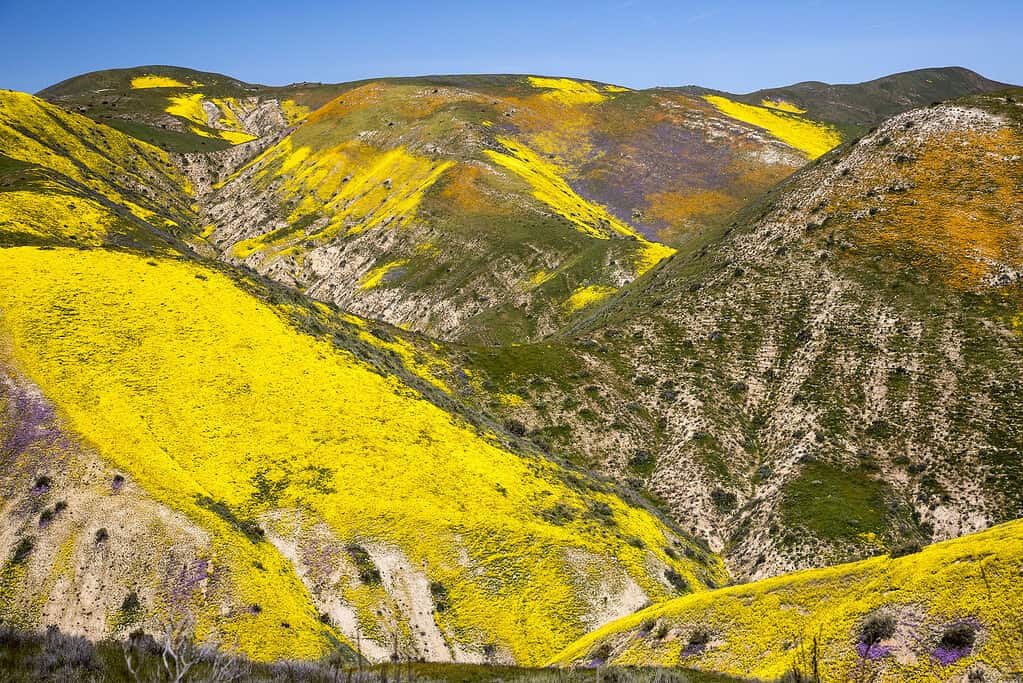
Joshua Tree National Park
Located in Southern California, Joshua Tree National Park is famous for its striking rock formations and twisted Joshua trees. During the superbloom, the park is transformed into a colorful wonderland, with carpets of wildflowers covering the desert floor. Some of the most common flowers you will see include desert marigold, brown-eyed primrose, and lupine.
Walker Canyon
Located in Lake Elsinore, Walker Canyon is a popular destination for superbloom seekers. The canyon is home to vast fields of orange poppies, along with lupines and other wildflowers. During the peak of the bloom, the canyon can become quite crowded, so it’s best to visit early in the morning or on a weekday if possible.

FAQ about the superbloom in California
A superbloom occurs when there is an abundance of rainfall in California during the fall and winter months. This extra moisture allows dormant seeds to sprout and grow, leading to a massive display of wildflowers in the spring. See the bullet point in the previous section for a more detailed explanation.
A superbloom is a rare event that only happens once every few years, and sometimes even decades. The last major superbloom in California occurred in 2019, and before that in 2017. There’s no regular schedule.
The timing of the superbloom varies depending on the location and weather conditions. In general, the bloom usually starts in late February or early March and peaks in April or the first half of May. However, it’s best to check bloom reports and weather forecasts before you go to ensure that you catch the bloom at its peak.
The duration of the superbloom also varies depending on the location and weather conditions. Some blooms may only last a few weeks, while others may last several months. It’s best to check bloom reports and visit early in the season to ensure that you catch the bloom at its peak.
The superbloom is a natural event that occurs as a result of weather patterns and natural processes. However, human activity, such as trampling on the flowers or picking them, can be harmful to the environment. It’s important to follow park rules and stay on designated trails to minimize damage to the ecosystem.
It depends on the location and park rules. Some parks allow dogs on designated trails, while others prohibit them altogether. It’s important to check park rules before you go and make sure that you follow them to ensure a safe and enjoyable experience for everyone. Some parks may have special regulations in place for the duration of the superbloom — always check it out before going for the trip.
It’s important to bring plenty of water, sunscreen, and comfortable walking shoes. The weather can be unpredictable, so it’s a good idea to dress in layers and bring a hat or sunglasses to protect yourself from the sun. Additionally, it’s important to bring a camera to capture the beauty of the superbloom, but remember to leave the flowers for others to enjoy.
To fully enjoy the superbloom, it’s important to take your time and soak in the beauty of the flowers. Be sure to bring a picnic lunch and find a quiet spot to relax and take in the scenery. Additionally, it’s a good idea to visit during the week when crowds are smaller and the parks are quieter.
The types of flowers you’ll see during the superbloom vary depending on the location, but some common flowers include poppies, lupines, wild mustard, and desert marigolds. Other flowers you may encounter include California lilacs, wild hyacinths, and owl’s clover. The colors of the flowers range from bright yellows and oranges to deep purples and blues, creating a stunning display of natural beauty.
It’s important to remember that the flowers are there for everyone to enjoy, and picking them can damage the ecosystem and prevent others from experiencing the beauty of the superbloom. It’s also important to note that picking flowers is illegal in most parks and can result in fines.
It’s important to remember that you are visiting the animals’ home and to respect their space. Keep a safe distance from wildlife and never approach or feed them. If you encounter a snake or other potentially dangerous animal, give it plenty of space and avoid disturbing it.
While the superbloom is a beautiful natural wonder, it’s important to be aware of potential safety hazards. Be sure to stay on designated trails and avoid walking on steep or unstable terrain. Additionally, be sure to check park regulations and watch for warning signs regarding potential hazards such as flash floods or steep drops.
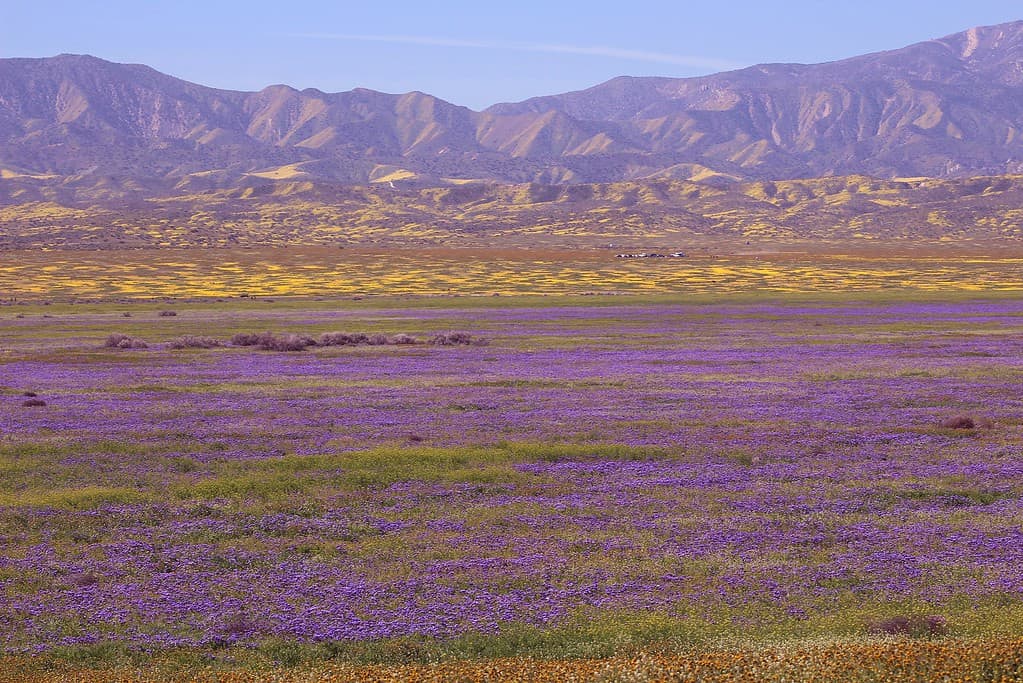
Conclusion
The California superbloom is a spectacular display of nature’s beauty, a rare event that transforms the landscape into a vibrant sea of wildflowers. If you’re planning to visit California, the superbloom is a must-see experience that you won’t want to miss — especially as it doesn’t happen very often.
During a superbloom, the hills and valleys of California are transformed into a vibrant carpet of wildflowers, with bright colors and sweet fragrances filling the air. Some of the most common flowers you will see during a superbloom include California poppies, lupines, and goldenfields. These flowers can grow in abundance, covering entire hillsides and providing a stunning display of nature’s beauty.
Remember to check bloom reports and weather forecasts before you go, and be sure to visit early in the morning to avoid the crowds. With the right preparation and a sense of adventure, you’re sure to have a memorable and awe-inspiring experience during the superbloom.


